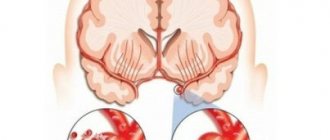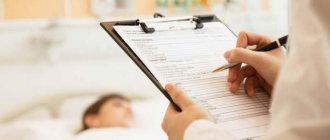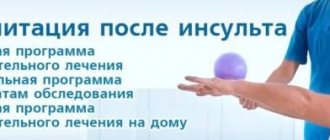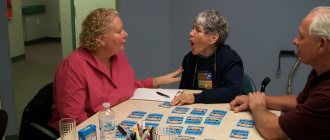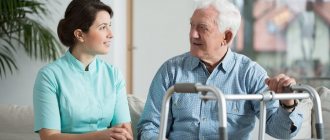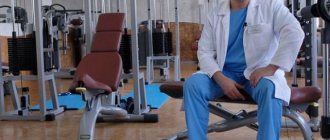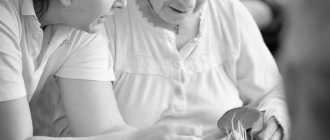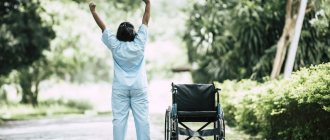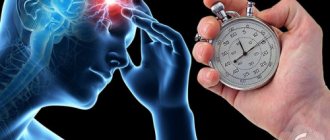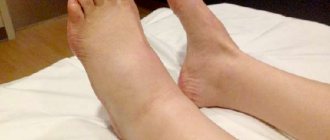10 minutes
A stroke is an acute disorder of cerebral circulation, leading to the destruction of brain tissue. Every year in Russia there are 450,000 cases of stroke - one every 1.5 minutes.
The causes of ischemic stroke can be atherosclerosis of cerebral vessels, coronary heart disease with cardiac arrhythmias, heart defects, osteochondrosis of the cervical spine, and arterial hypertension. With these diseases, obstruction or blockage of brain vessels develops, the blood supply to the brain is disrupted, which leads to bleeding of the brain - ischemia. If blood circulation in the ischemic area is not quickly restored, the brain tissue in it dies. The dead tissue then gradually dissolves to form cysts (holes) in the medulla.
The consequences of ischemic stroke are determined 90% by its severity and only 10% depend on treatment. Therefore, preventing stroke is many times more effective than treatment; Hippocrates said: “It is easier to prevent a disease than to treat it.”
Stroke prevention: simple rules for preventing stroke
Care after ischemic stroke
The patient should be in a bright, well-ventilated room, protected from extraneous noise, in which wet cleaning should be carried out regularly, at least 1-2 times a day.
The room should be ventilated several times a day so that the patient is not in a draft, and the average air temperature in the room is maintained at + 18-22 degrees.
Beds with sagging metal mesh cannot be used. It should be tightly stretched and covered with a dense mattress, for example foam rubber - the most hygienic and comfortable.
The caregiver is recommended to keep a diary in which to record indicators characterizing the patient: blood pressure, pulse, body temperature (it must be measured at least 3 times a day), the amount of fluid consumed (drinks, liquid dishes, fluid administered by infusion), the amount of excreted urine, frequency of bowel movements.
It is necessary to monitor the regularity of following the doctor's prescriptions.
To prevent congestion in the lungs, bedridden patients should do breathing exercises several times a day. The simplest type of breathing exercise is inflating a balloon.
In order to prevent bedsores, every 2-3 hours it is necessary to turn the patient over in bed, while performing a light massage of the skin on the back and sides of the chest, buttocks (stroking, rubbing). Special inflatable rings are placed under areas of the body where the risk of developing pressure sores is highest (heels, elbows, shoulder blades, buttocks, back of the head).
It is necessary to monitor the cleanliness of the patient's skin: regularly wash the patient's body with towels soaked in a weak soap solution, then wipe the skin dry. In some cases, camphor alcohol is used to cleanse the patient's skin.
After each meal, you need to clean your mouth of food debris.
Be sure to monitor the condition of the skin in natural folds (perineal area, groin and armpits, in women - under the mammary glands), as well as in fat folds. Areas of skin redness (maceration) should be treated with a gauze swab moistened with a pink solution of potassium permanganate or camphor alcohol.
If bedsores appear, you should consult a doctor about the rules of their treatment.
What should you do to prevent stroke?
The most important thing to prevent cerebrovascular accidents and stroke is to control blood pressure. Studies are also needed to show the condition of the blood vessels:
- fundus examination;
- pressure measurements throughout the day;
- ECG;
- general blood test and biochemistry;
- coagulogram (diagnosis of blood clotting);
- control of all chronic diseases that increase the risk of stroke (heart disease, diabetes, carotid artery stenosis).
Stroke Prevention
Rehabilitation after ischemic stroke
Basic principles
1. Early start of the rehabilitation process - from the first hours of stroke development. At the very beginning, this is primarily:
Correct positioning of affected limbs
To prevent bedsores and the respiratory system, you should lie on both the healthy and paralyzed side. The healthy leg should be straightened, and the paralyzed leg should be brought forward slightly, slightly bent and placed on a pad. Place a pillow under the paralyzed arm.
To lie on the painful side, you should place a pillow under the patient's back to relax the muscles and stabilize him so that he does not roll out of bed. The paralyzed arm should be extended forward. Straighten your arm and place your palm up.
Attention: Do not lie on the paralyzed side for a long time.
The patient can lie with his head elevated for 15-30 minutes 3 times a day, starting from the first day of the disease.
Regularly changing the position of a post-stroke patient in bed
The position of the body in bed should be changed as often as possible. Prolonged pressure on the same areas of the body can lead to the formation of bedsores.
The patient’s position in bed should also be changed to improve bronchial function. If the patient is constantly in the same position, then sputum from some bronchi, under the influence of gravity, flows into the trachea and is coughed up, but from other bronchi, on the contrary, does not flow. And stagnation in any hollow organ leads to its inflammation. Even in the absence of dangerous microorganisms, microbes begin to multiply in the area of stagnation, which leads to pneumonia, which is difficult to cure in a weakened person. Frequent turns in bed help avoid this complication.
Massage
The massage procedure contributes to the overall health of the body, normalization of blood circulation in various parts of the patient’s body, restoration of lost functions or their compensation, normalization of muscle tone, increased joint mobility, elimination of trophic disorders in paralyzed limbs. The pathology of the connection between the muscles of a paralyzed limb and the nervous system leads not only to immobilization of the limb, but also to disruption of tissue nutrition.
Massage after a stroke
Therapeutic exercise (physical therapy)
Exercise therapy is a method of prevention using exercise, often combined with physical therapy and massage.
Exercises for recovery after a stroke
The sooner rehabilitation measures are started, the more lost functions will be restored or compensated.
2. Systematic long-term treatment over many months and sometimes years. Therapy (drug and non-drug) should continue in accordance with the recommendations of the attending physician.
3. Rehabilitation must be comprehensive. It is necessary to combine drug treatment with physical, psychological and speech therapy.
4. Consistency and phasing. At each stage, specific tasks should be set to restore lost functions. After completing the stage, the tasks change as your health improves.
5. Active participation of the patient and his family in the rehabilitation process.
Hyperbaric oxygenation
In diseases when the delivery of oxygen to organs and tissues is disrupted, including ischemic stroke, hypoxia develops - oxygen starvation. The brain is especially sensitive to a lack of oxygen and cannot function normally when it is deficient. In such situations, a modern treatment method, a type of oxygen therapy - hyperbaric oxygenation (HBOT), is used to improve oxygen supply.
Oxygen therapy: treatment and prevention of diseases
Hyperbaric oxygenation is a treatment method using pressure chambers in which the patient breathes an air mixture with an oxygen concentration 5 times higher than normal air. Due to the increased pressure and concentration, oxygen easily and quickly dissolves in the blood and is distributed throughout the body with its current. All tissues of the body are saturated with oxygen, even those in which blood circulation is impaired.
As a result, metabolic processes and blood circulation are improved, the neutralization and removal of waste and harmful substances from the body is accelerated, the functioning of all internal organs is normalized, the body's need for medicinal substances is reduced and their therapeutic effect is enhanced.
In addition, HBO has an anti-edematous effect, promotes the proliferation of blood vessels and restores blood supply to the affected areas of the brain.
Treatment can only be carried out after consultation with a doctor.
Physiotherapy
After a stroke, electromyostimulation, darsonvalization (electrotherapy), faradization (treatment using low-frequency alternating current in pulsed mode), balneotherapy (hydrotherapy), acupuncture, phototherapy and treatment with ionized air are prescribed.
Physiotherapy sessions are held at the Cardiological Sanatorium. The following medical services are also provided: hydrotherapy, inhalations, therapeutic massage, herbal medicine, exercise therapy and drug therapy.
Aromatherapy
The use of the following essential oils is recommended: oil of styrax benzoin, black pepper, eucalyptus, garlic, geranium, ginger, juniper, lemon, tangerine, rosemary, clary sage, thyme.
Oils are used for massage, as bath additives, and to scent the air.
How to improve cerebral circulation?
Sunday, December 12
917
5
Content
- Why is it important to maintain normal blood circulation in the brain?
- Cerebrovascular accident and stroke
- Why does cerebrovascular accident occur?
- What should you do to prevent stroke?
- What medications are there to prevent stroke?
- Drugs for stroke prevention
- Warfarin
- Dilakor
- Cinnarizine
Our brain is, in fact, the center that controls the entire body. The brain regulates the functioning of muscles, organs and systems, and is responsible for memory, thinking, attention and speech. Unfortunately, cerebral circulation can deteriorate with age, due to certain diseases or due to stress. In this article we will talk about the causes of cerebrovascular accidents and stroke prevention.
Read also: Top 10 best blood thinners Blood thinners
What medications are there to prevent stroke?
There are many drugs on the market today with different effects that improve cerebral circulation. Such treatment can only be selected by a doctor after a thorough examination. Types of drugs for stroke prevention:
- Anticoagulants and antiplatelet agents.
Such medications are prescribed to prevent thrombosis. They thin the blood, help it flow faster, and prevent blood clots from attaching to the walls of blood vessels. Among such drugs: “Cardiomagnyl”, “Curantil”, “Warfarin”, “Trental”, “Thrombo ACC”. - Vasodilators.
These drugs improve blood circulation in the brain, dilating blood vessels and reducing blood pressure. Thanks to this, the blood better nourishes the tissues. Brain hypoxia passes, and it begins to receive all the necessary nutrients. Among such drugs: “Enalapril”, “Isoptin”, “Phenigidine”, “Verapamil”, “Dilacor”. - Nootropics.
Such drugs improve metabolic processes in tissues, improve blood circulation in the brain, and help brain cells function properly during oxygen starvation. Typically, such drugs are prescribed in complex therapy for the treatment of chronic or acute cerebrovascular accidents. Among such drugs: Phezam, Piracetam, Cinnarizine, Cerebrolysin.
